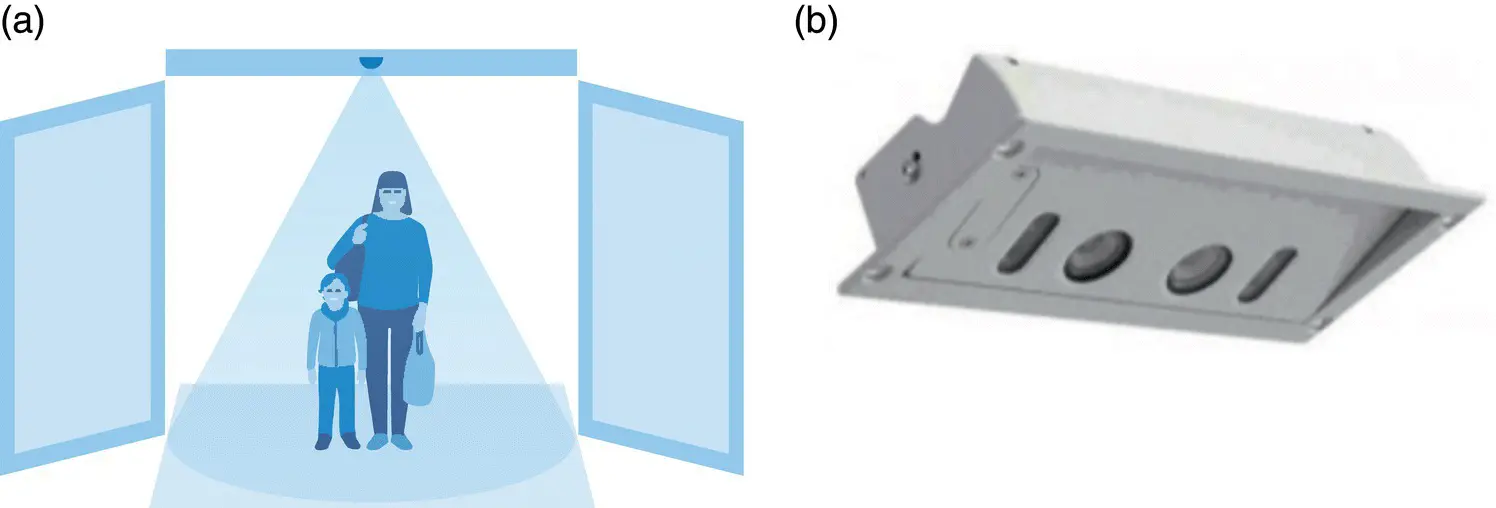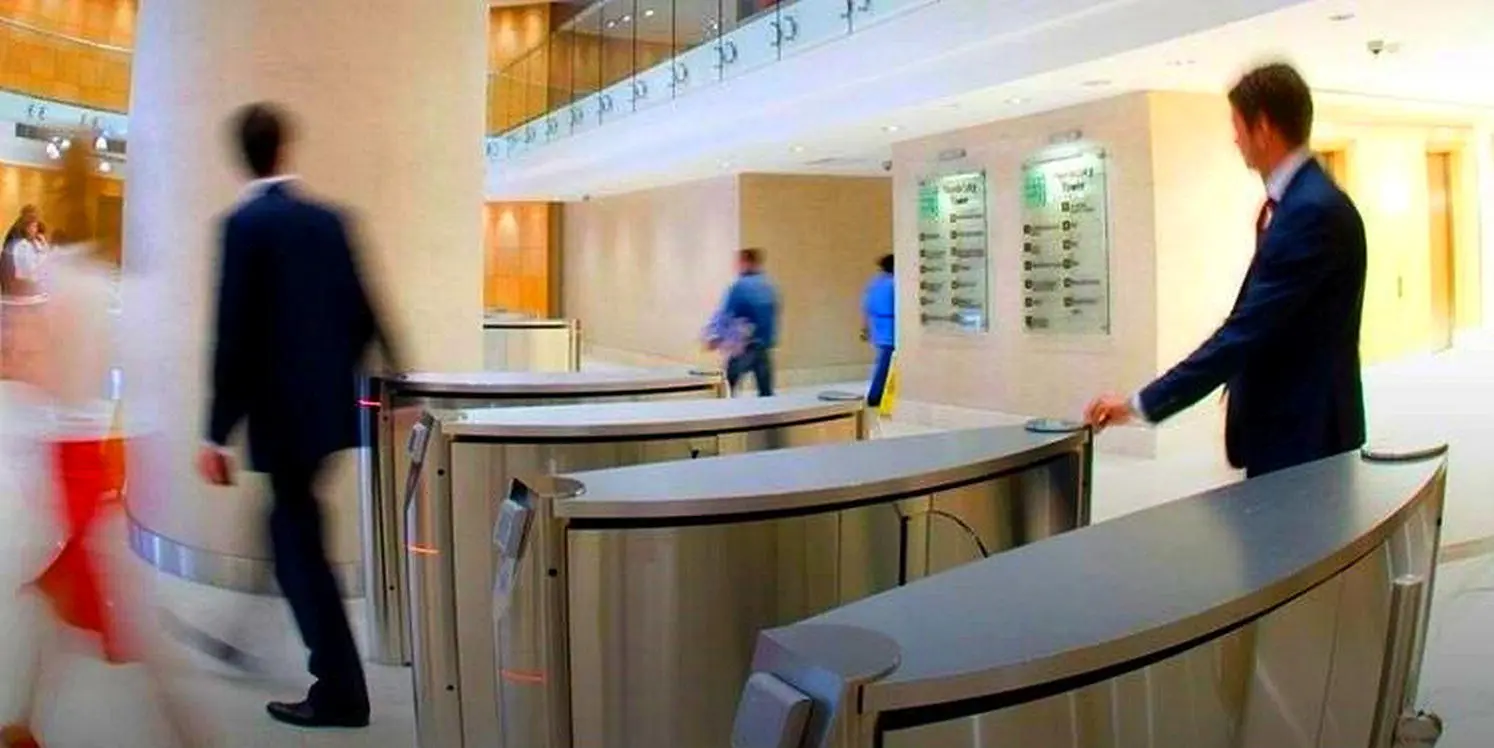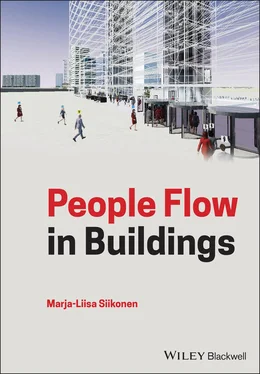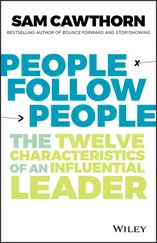1 ...7 8 9 11 12 13 ...16 ( Source: Siikonen and Kaakinen (1993 ). © John Wiley & Sons).
2.3 Manual People‐counting
Manual counting gives random samples of the daily passenger traffic in buildings. Counting can be performed at elevator lobbies, inside elevators, or for instance from closed‐circuit television ( CCTV ) video recordings.
Pen and paper method does not require special technological knowledge or investment in technical devices. To find out vertical traffic, checkers can register the passengers getting on and off the elevators with time stamps, see Table 2.1. Additional information such as if the car was travelling up or down may be added. The data is later analyzed for desired intervals, which is called the post‐sampling method. This method is flexible for research purposes. Another alternative is the pre‐sampling method, where passenger arrivals are counted for predefined intervals.
Table 2.1 Minimum information for counting passengers in an elevator lobby.
| Building information, lobby, floor index, checker |
| Time stamp |
Enter |
Exit |
Group size |
| 8:01 |
2 |
0 |
1 |
| 8:03 |
1 |
1 |
4 |
| 8:04 |
3 |
0 |
1 |
| … |
|
|
|
If there are several entrance floors, counting should be done simultaneously at each entrance. From this data, the floor or building occupancy during the measurement period can be estimated. Manual counting at the main entrances does not include the traffic on upper floors nor the information of passenger journeys. To be able to count the inter‐floor traffic on upper floors, persons should stand in the lobbies of each level and record the passenger transfers in to and out from the elevators with time stamps. The direction of the car and floor index should be included in the data. A less laborious approach is if there is a traffic checker in each car who writes down the passenger transfers in to and out of the car with time stamps during each stop. Also, the floor index as well as the direction of the car should be recorded. For passenger journey information, the origin and destination floors of each passenger should be recorded as well, but this is quite a demanding task for one person.
The problem with manual counting is the accuracy, consistency and reliability of the data with several checkers. Capable data collection resources are often limited since the counting is labour‐intensive and time‐consuming. From the random samples of daily traffic, it is difficult to form trends or forecasts of the traffic.
2.4 Use of Optical Vision
In‐house people‐counting with cameras and video techniques has become popular since the sizes of cameras have rapidly decreased, and accuracy has improved during the last years. Also, the revolutionary development of storing data to DVDs, flash memories and cloud services has accelerated the development and use of optical vision. In Figure 2.2a camera is set above a doorway. Such passenger counters can be positioned also at the entrance doors (Footfallcam 2019 ).

Figure 2.2 Camera installed above the doorway for people‐flow counting (a) and optical vision with two stereoscopic cameras
( Source: Pinna et al. (2010 ). © U.S. Department of Transportation [US DOT]) (b).
Optical vision can be placed in the lobby entrances and on the roof inside an elevator. On elevator roofs, cameras have earlier been installed for safety purposes to detect unfamiliar objects inside a car, or to recognize the free space in the elevator. Optical vision solutions are able to detect even the shapes of the passengers and identify either the entry or the exit movements. Two stereoscopic cameras can be mounted perpendicular, normally 2–5 m, above the area to be detected, as in Figure 2.2b (Pinna et al. 2010 ). The measured data can be saved to a main computer, or streamed to a server or to cloud. Along with the video image, the date and time are recorded which allow later statistical analysis. Video analytics employs, e.g. a multilayer technique to distinguish only the moving objects on the video where the background is subtracted from the foreground image (Yao and Odobez 2017 ). There are multiple suppliers for the camera‐based technique. With 3D‐cameras, the data is more stable compared to the normal 2D‐cameras. These types of sensors are capable of finding, for instance, the visitor counts in a football stadium, or the duration of customer visits in shopping malls.
2.5 Visitor‐counting with Photocell Signals and Infra‐red Beams
In building entrances and doorways of transportation devices such as buses, tramways and trains (Pinna et al. 2010 ), in elevators and escalators, photocell devices, ultrasonic detectors, or infra‐red beam detectors or light‐curtains are often used as safety devices. If someone is detected in between or in close proximity to the doors, the doors are prohibited from being closed. The photocell signals can also be used to count passengers, or to start an escalator being in standby mode. A passenger moving through a doorway causes a cut in the photocell signal. With one pair of devices the direction of the passenger transfer, however, cannot be distinguished. To determine the direction of movement, at least two signals, a light‐curtain ( Figure 2.3a), or a proximity sensor are needed ( Figure 2.3b). A two‐dimensional (2D) light‐curtain has transmitters of infra‐red beams on one side of the door opening, and receivers on the other side of the opening. A light‐curtain can recognize passengers as long as they are in between the doors. This provides comfort, e.g. for disabled people for whom the untimely closing of doors causes problems. In a three‐dimensional (3D) proximity sensor, some infrared transmitters and receivers are set at an angle where the beams reflect from the obstacle back to the receivers. When the doors start to close, the area recognized by the proximity sensor decreases (Strakosch and Caporale 2010 ). Advanced proximity sensors can detect a passenger and estimate the distance as well as the direction of the passenger movement (Backlund 2015 ).

Figure 2.3 Curtain‐of‐light (a), and infra‐red proximity sensor (b) in a door opening.
2.6 People‐counting with Access Control System
In office and residential buildings, access control is often used for the building occupants to allow them to enter only defined floors or areas of a building. An access reader recognizes persons from identification codes (ID) inserted by mobile devices, magnetic or smart cards. The recent access reader innovations are based on biometric identification, such as face, fingerprint or iris recognition. Typically access readers are placed beside building entrance doors or in turnstiles. Security gates open when a passenger wipes the access card at the card reader ( Figure 2.4). With access control systems, the number of passenger transfers can be counted and their vertical journeys from origin to destination floors recorded.

Читать дальше















